Self-Interference Elimination by Physical Feedback Channel in CCFD for 3-D Beamforming Communication
Naveed Ali Kaimkhani, Zhe Chen, Fuliang Yin
School of Information and Communication Engineering, Dalian University of Technology, Dalian116023, China.
* The corresponding author, email: Flyin@dlut.edu.cn.
I. INTRODUCTION
Emerging technology, such as Multiple-Input Multiple-Output (MIMO), can provide an outstanding promotion in data reliability and throughput [1, 2], without sacrificing additional bandwidth or energy consumption. Nowadays, a new MIMO system design is cited as a massive MIMO that has been aimed with significant potential of escalating both energy and spectral efficiency [3, 4]. Moreover, it has a disruptive potential for the future wireless communication [5]. Nevertheless, implementation of massive number of antenna arrays on transceiver is an enormous challenge.Three-dimensional beamforming (3-D beamforming) is an efficient technique to access massive MIMO with-out the help of employing enormous antenna arrays on transceiver.3-D beamforming exploits the vertical dimension in the antenna prototyping, and down-tilt of the antennas modeling will turn into considerable channel parameters [6]. However,a conventional two-dimensional (2-D) beamforming solutions are matured enough but, still 2-D beamforming edge users are facing the inter-cell interferences from neighbor’s cells.Furthermore, 2-D beamforming antenna array is only useful to cover sector region up-to 120 degrees in horizontal sphere [7]. Whereas, the 3-D beamforming transmission has capability to resolved the inter-cell interferences issue by dividing the users into horizontal and vertical direction transmissions and managing users per resource (such as transport time interval(TTI) and users basis) with the help of interference coordination method [8]. While, the 3-D beamforming transmission is only feasible by half duplex communication that increases the time cost and TTI processing delay by handling uplink and downlink transmissions separately [9]. 3-D beamforming is used in channel state information (CSI) to design pre-coders at the BTS whereas, the receiver estimated CSI is acquired at BTS in Frequency domain duplex(FDD) or Time domain duplex (TDD) through exploiting the channel reciprocity, either pilot based channel assessment or uplink training assessment, respectively [10, 11]. While, these methods consume significant spectrum and energy resources, it affects the spectrum and energy efficiency.
In this paper, physical feedback based self-interference cancelation in CCFD is proposed to amend the effectiveness of spectral and energy consumptions in the 3-D beamforming.
Co-frequency and Co-Time Full Duplex(CCFD) provides a promising solution to overcome the drawbacks of spectrum and energy consumption. CCFD is distinct as a transceiver that can simultaneously communicate between transmitter and receiver at the same time and frequency domain to improve spectrum and energy efficiency. In CCFD communication scheme, self-interference (SI) problem springs up when a full-duplex node transmits and receives simultaneously within the same frequency-and-time-domain [12]. The self-interference is often a little order of strength larger than the original signal, because the transmitter node is nearer than the same receiving node. Hence, the SI cancellation is a critical chore in CCFD communication scheme.Furthermore, the analog-to-digital convertor(ADC) at receiver goes through the saturation state, because of this, the Interference-to-Signal Ratio (ISR) at the ADC input is not high enough to prevent the desired signal by the extra quantization noise [13]. Thus, the SI in the CCFD transceiver should be concealed before quantization at the radio frequency (RF)step, to provide an effectual communication between transceiver.
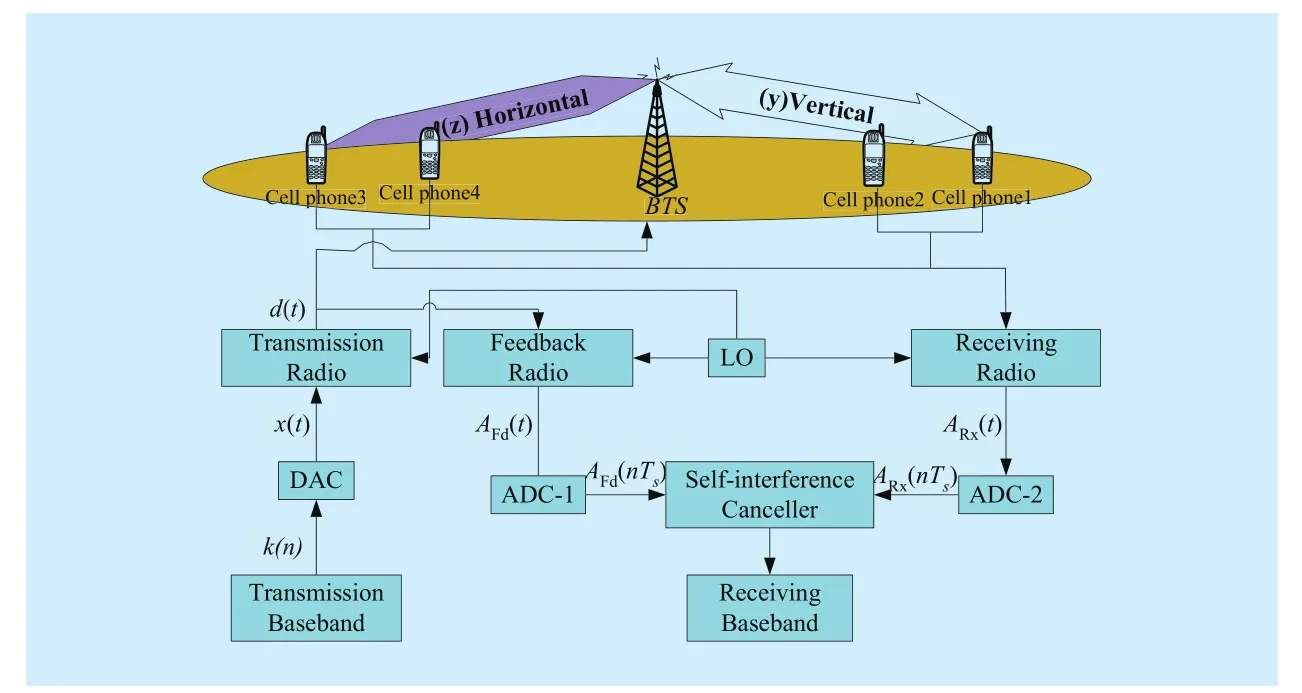
Fig. 1 System model
Recently, the SI cancellation has obtained developing consideration. In the latest research, there are two sorts of structures for the execution of the SI cancellation at the RF level. The first approach is concluded in [14-17], in which a reproduction of the RF signal tied from the nearest transmitter is viewed as a reference signal. The fundamental idea for this configuration is to adaptive changes in the reference signal parameters to acquire the estimation of SI, and deduct it from the received signal. In [14] and [15], the amplitude and delay of the reference signal are manually regulated, and the feasibleness is affirmed at the 530MHz and 2.4GHz for self-interference elimination. A different approach of in-phase and quadrature reference channels is used in[16-17] to eliminate the SI by manual adjustment of attenuators for both channels, and feasibleness is also verified at the 2.4GHz for SI cancellation. The second structure is computed by digitally self-interference elimination in CCFD communication network. While,the literature information about digitally SI elimination in CCFD framework is fairly limited. It is restricted due to non-linearity,quantization noise and phase noise in digitally self-interference elimination. The phase noise is recognized as the principle bottleneck in elimination that cannot be conquered with the traditional digital SI elimination schemes.In digitally SI cancellation, a replica of bitstream as the transmitter is fed by feedback channel for transceiver to especially produce a SI estimated radio frequency (RF), which can help suppressing the SI from the received signal. Despite the fact that [18, 19] utilize feedback channel with guided signal to quanti-fy the self-interference channel at baseband to eliminate the self-interference, but there is an absence of satisfactory investigation in principle. The existing literature also has a little information on digital feedback SI elimination technology regarding non-linearity and quantization noise.
The mostly existing scheme of 3-D MIMO beamforming is based on half duplex (FDD or TDD) scheme to improve throughput performance, interference reduction and specific data base center seniors [20]. While, the novelty of our proposed work is based on Co-frequency Co-time Full duplex based 3-D beamforming scheme. Whereas, the 3-D beamforming downlink and uplink transmission are handled simultaneously to improve the spectral and energy efficiency by reducing time cost and TTI processing delay. Furthermore, it is also discussed about eliminations of non-linearity,phase noise (at transceiver) and quantization noise for avoiding self-interference in CCFD.
The residual sections are organized as follows; Section II describes the system model,3-D beamforming based on CCFD communication is discussed in section III, Section IV explains about proposed self-interference suppression in CCFD based on 3-D beamforming scheme, Simulation results are given in Section V and finally conclusion is summarized in Section VI.
II. SYSTEM MODEL
The system model of CCFD based 3-D beamforming scheme is comprised of feedback based self-interference suppression to improve the spectrum and energy efficiency.In our work, 3-D beamforming transceiver are equipped by vertical (y) and horizontal(z) antenna directions with transmit antenna arrays NTxand receiving antenna arrays NRx.The corresponding inter-antenna arrays spacing is defined as byand bzin the vertical and horizontal direction by settingand, respectively whereas, the beam pattern in the 3-D beamforming that can be stated as

where θ and φ are the altitude angles and azimuth in spherical aligns, respectively. Furthermore, defineas the product of vectorwhereas noisesis composed offor nTx=1, 2,….,NTxand nRx= 1, 2,….,NRx, andis the representing direction-finding vector.
As per indicated by 3GPP TR 36.814 V9.0.0 [21], the height radiation design and azimuth for a solitary component are characterized as (2) and (3), separately.
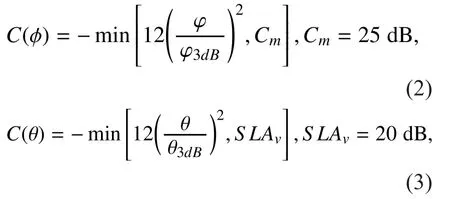
where the Cmand SLAvare representing the front-to-back attenuation and side-lobe attenuation, separately. As indicated in [21], the 3D synthesized beamforming array can be express as

To implement a performance valuation for the 3-D beamforming, the signal-to-interference- plus-noise ratio (SINR) is represented as

The CCFD based 3-D beamforming is discussed in figure 1 to eliminate the non-linearity quantization noise and phase noise by feedback channel self-interference suppression.Subsequently, the digital transmission baseband signal k(n) is converted into the analog signal x(n) through digital to analog conversion (DAC) at transmitter side, that’s induced the quantization noise in the transmission signal. Furthermore, the converted transmission signal is further amped and up-transform to the radio frequency (RF) signal d(t) via radio transmission, that brings up the non-linearity and phase noise in transmission. At the receiving side, the transmitted signal along with self-interference is received at receiving antenna, the receiving radio further down-transform received analog signal ARx(t), that brings up the non-linearity and phase noise. Later on, the analog to digital conversion (ADC-2) is used to convert from ARx(t) to ARx(nTs), that cause the quantization noise at the receiver side. In addition, the RF signal d(t) is also used to couple the self-interference suppression signal by feedback channel whereas, the coupled signal is down-transform with the help of feedback radio channel, that is further converted from analog signal to digital signal AFd(nTs) through ADC-1.
As discussed above, receiver has awareness about non-linearity, quantization noise and phase noise of the transmission through feedback channel; additionally, the LO is shared between feedback radio and receiver radio,whereas, the phase noise information is shared by feedback channel to the receiver that can be helpful to eliminate the phase noise at receiver side.
III. HOW THE CCFD EFFECTIVE TO IMPROVE THE 3-D BEAMFORMING COMMUNICATION
Three-D beamforming transmission is based on Vertical and Horizontal antenna arrays. It used half duplex communication system that’s based on frequency reused factor. Frequency reused exploited the spectrum efficiency that causes extra processing efforts to choose appropriate frequency, delay which effects on power. An energy efficient network can be designed with the help spectrum efficiency.Power leakages and interferences are the key factors to severely limit the beamforming transmission in wireless communication.
However, up to now, only statistical effects have been exploited for interference reduction.The question is how established interference coordination techniques can be advantageously combined with 3D beamforming, and which additional performance gains can be achieved.Interference coordination in general considers additional information about resource usage and scheduling of adjacent cells. Based on this, the resource assignment in each cell is optimized to reduce the impact of interference on spectral efficiency and throughput.
A full duplex communication system is quite effective to improve 3 D beamforming performance by avoiding interference. While,the self-interference problem arises when a node transmits and receives simultaneously in the same frequency band (also known full duplex communication). CCFD system has made it conceivable for transceiver to communicate simultaneously by self- interference suppression techniques. There are numerous solutions are accessible to remedy the self-interference issues in CCFD. Such as: Passive propagation suppression, Active analog cancelation (Cancel interference through analog portion) and Active digital cancelation (Cancel interference in the baseband) etc…One of them is digital suppression, which is limited by non-linearity,quantization noise and phase noise. The phase noise, which is identified as the main bottleneck in cancellation, cannot be completely suppressed by the traditional self-interference suppression methods.
IV. SELF-INTERFERENCE SUPRESSION IN CCFD BASED 3-D BEAMFORMING
In this paper, we propose an energy and spectrum efficient 3-D beamforming scheme by feedback based SI suppression in CCFD communication. Traditional 3-D beamforming based on vertical and horizontal antenna configuration by exploiting spectrum and energy efficiency by FDD/TDD and antennae cell sectorization. While, the proposed scheme is designed as to suppress the non-linearity,quantization noise and phase noise information at the receivers to eliminate the self-interference in CCFD. CCFD approach is quite effective method to improve the energy and spectrum efficiency in 3-D beamforming system by managing downlink and uplink transmissions, simultaneously.
Here, the analytical performance of the proposed feedback based self-interference suppression scheme is analyzed and compared with the traditional schemes, which is discovered to be better than the traditional strategies.
The digital signal k(n) is transformed by DAC at transmitter site into analog signal x(t)as

where k(t) is the analog signal analogous with k(n), and the digital to analog conversion(DAC) at transmitter brought the quantization noise qDAC(t). And so, x(t) is up-transformed and amplified before transmission, transmit signal d(t) can be expressed as

where ETxis the energy of transmitted signal,gTxis defined as the thermal noise of transmission, f (.) represents the non-linearity of the transmission and the variables

corresponds to the up-transformed at the radio frequency wRFalong with the phase noise of the transmission φTx(t).
To eliminate SI, the transmitted signal d(t) is coupled-up and down-transformed with feedback channel to acquire as

where gFd(t), fFd(.), φRx(t),andsymbolize as the thermal noise, non-linearity distortion, feedback channel phase noise, path gain, time delay, and frequency offset among the feedback channel and the transmitting radio, respectively. The transmission radio and feedback channel has some frequency offset because the transmission radio shares the LO through the feedback channel, significanceAfterwards, the conversion of signal from analog to digital (ADC-1) at receiver site AFd(t) is represented as:


Meanwhile, the d(t) signal is getting at the receiving antenna by wireless channel. For the simplicity of analysis, it is assumed that the wireless channel is a single way and slow fading. At that point the received signal is down-transformed as

Afterward, analog to digital conversion(ADC-2), ARx(t) is mapped as

where qADC2,Rx(nTs) is defined as quantization noise at the (ADC-2).
The feedback based SI is eliminated according to AFd(nTs) in (10) and ARx(nTs) in (11).Now, we have the residual self-interference like

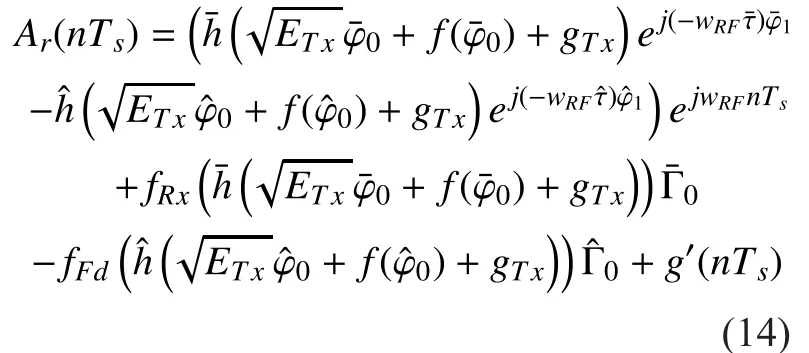
where

Conceiving that these factors (the nonlinearity and phase noise of the transmitter; the non-linearity, thermal noise, phase noise and the non-linearity of the feedback channel) are incredibly minor, the equation (14) can be modified as

where

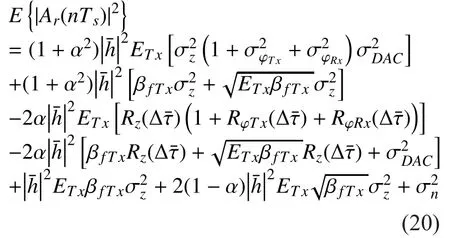
The efficiency of proposed feedback based SI scheme can be evaluated by two perspectives with traditional SI suppression scheme.The first feature of the proposed method is that the complete elimination of phase noise is possible, which is not tackled in the traditional scheme. And the other aspect is that the nonlinearity and quantization noise are suppressed in proposed method, while these features are not considered in the traditional method.
The lack of the non-linearity and the quantization noise in Eq. (20) the residual self-interference energy of the proposed self-interference scheme, it can be represented as
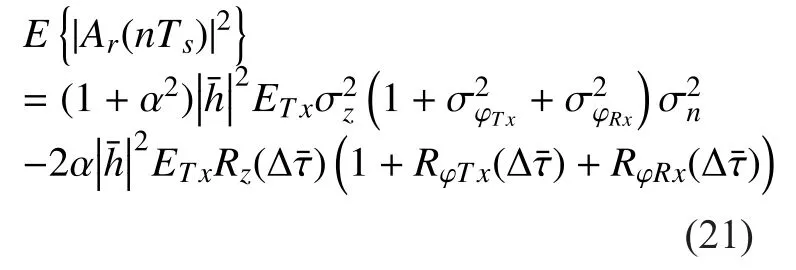


After successfully SI suppression in CCFD;the co-frequency and co-time full duplex can be affecting in 3-D beamforming to avail the spectrum and energy efficiency by downlink and uplink transmission, simultaneously.
V. SIMULATION RESULTS AND DISCUSSION
In this section, the analytical and simulation based performance of proposed scheme is evaluated with traditional methods in terms of SI suppression and bit error rate (BER). It is assumed that the transceivers can absolutely estimate the DOA information and channel state information of all subscribers. The standard parameters of comprehensive system simulation are specified in [23] “3GPP TR 36.873” as discussed in table 1.
The analytical and simulation performance of phase noise suppression is compared between proposed and traditional scheme [22] in figure 2, whereas the transmission phase noiseand receiver phase noiseare equal toAlongside,dBm,Whereas,the plots are design between phase noise cancellations in self-interference and delay time
It is proved by simulation and analytical results in figure 2 that the proposed scheme(withis superior to traditional scheme (withby improving performance up to 35dB and 25 dB, respectively. This is because the traditional scheme lacks phase noise information, that needs to be calculated at receiver site, weather the proposed scheme share the LO and self-interference information by feedback path with receiver. Even the results of the proposed simulation scheme are closer to proposed analytical results. While, the self-interference is decreased as delay timerises.
The analytical and simulation performance of the nonlinearity effects and phase noise are compared between proposed and traditional scheme in figure 3, whereas the simulation and analytical data is configures asETx=30 dBm,the transmission radio third-order intercept point (TOIP3=40dBm) and receiver radio third-order inter-cept point (TOIP3= 0dBm) whereas, the plots are design between phase noise and nonlinearity cancellations in self-interference and delay time
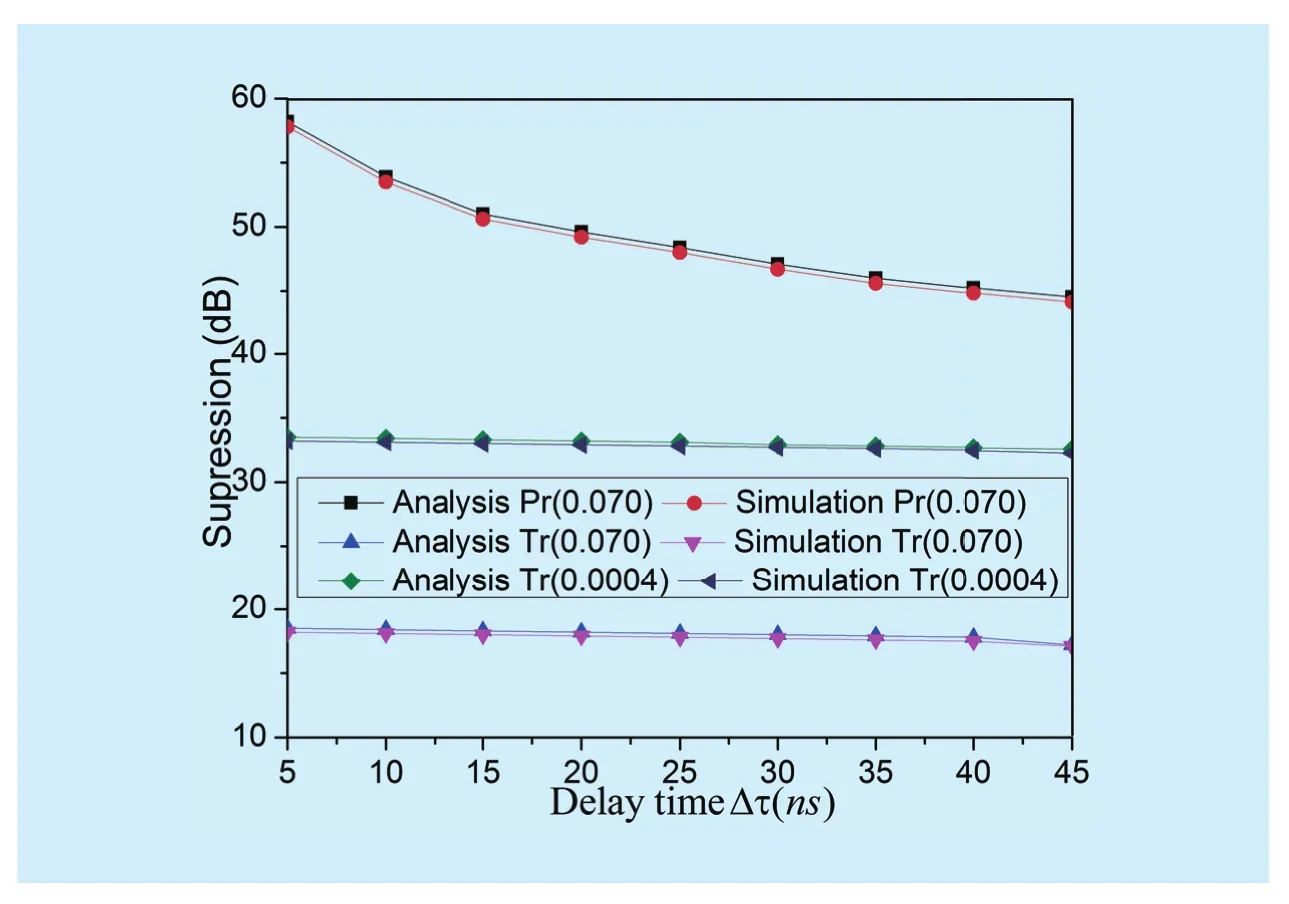
Fig. 2 Phase noise effects
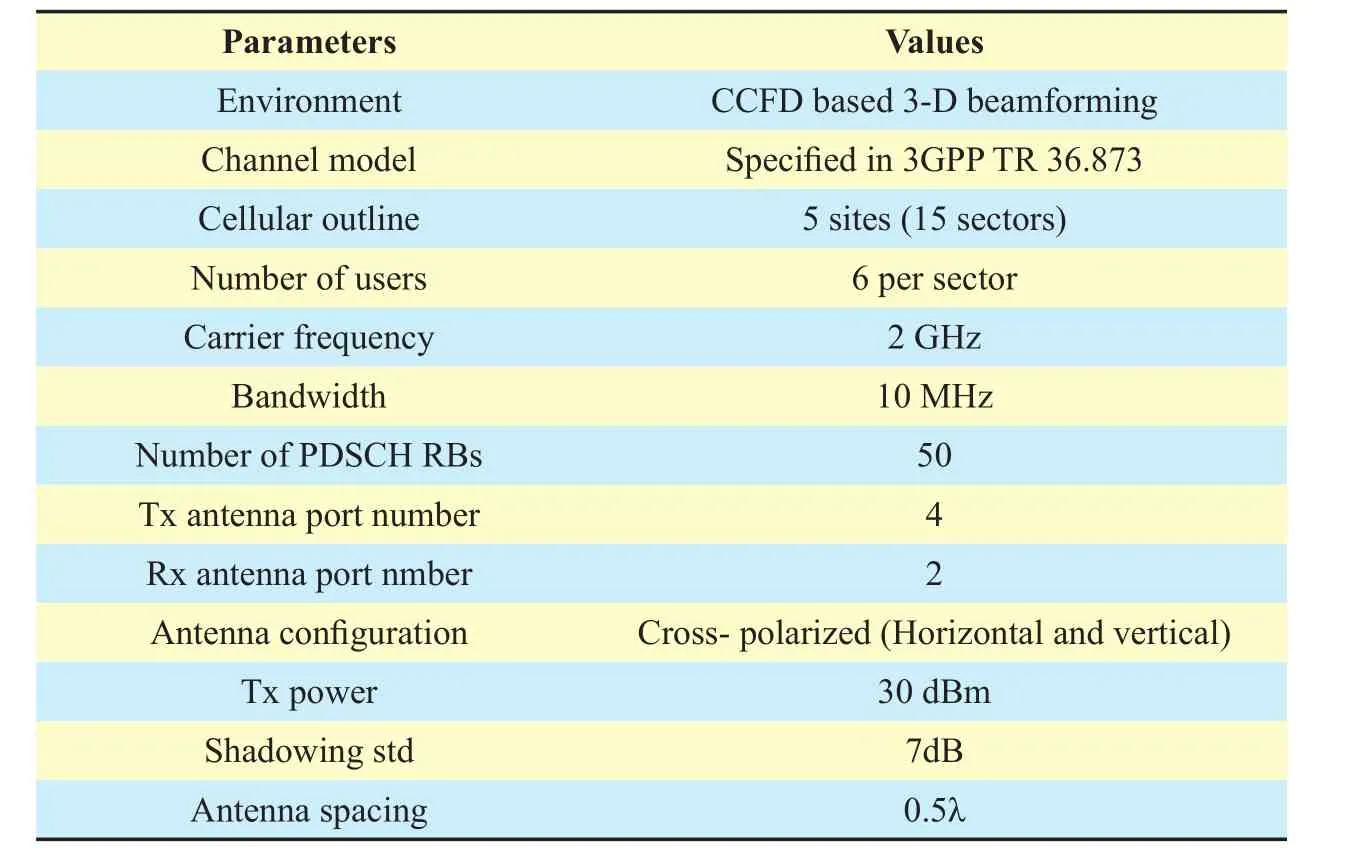
Table I Simulation parameters
As shown in figure 3, the proposed simulation results are quite closer to proposed analytical outcomes. The results also illustrate that the proposed scheme (withdB and) is quite superior than traditional method (with) by improving performance up to 35dB and 28 dB , due to efficiency of proposed feedback information to avoid nonlinearity in the scheme.
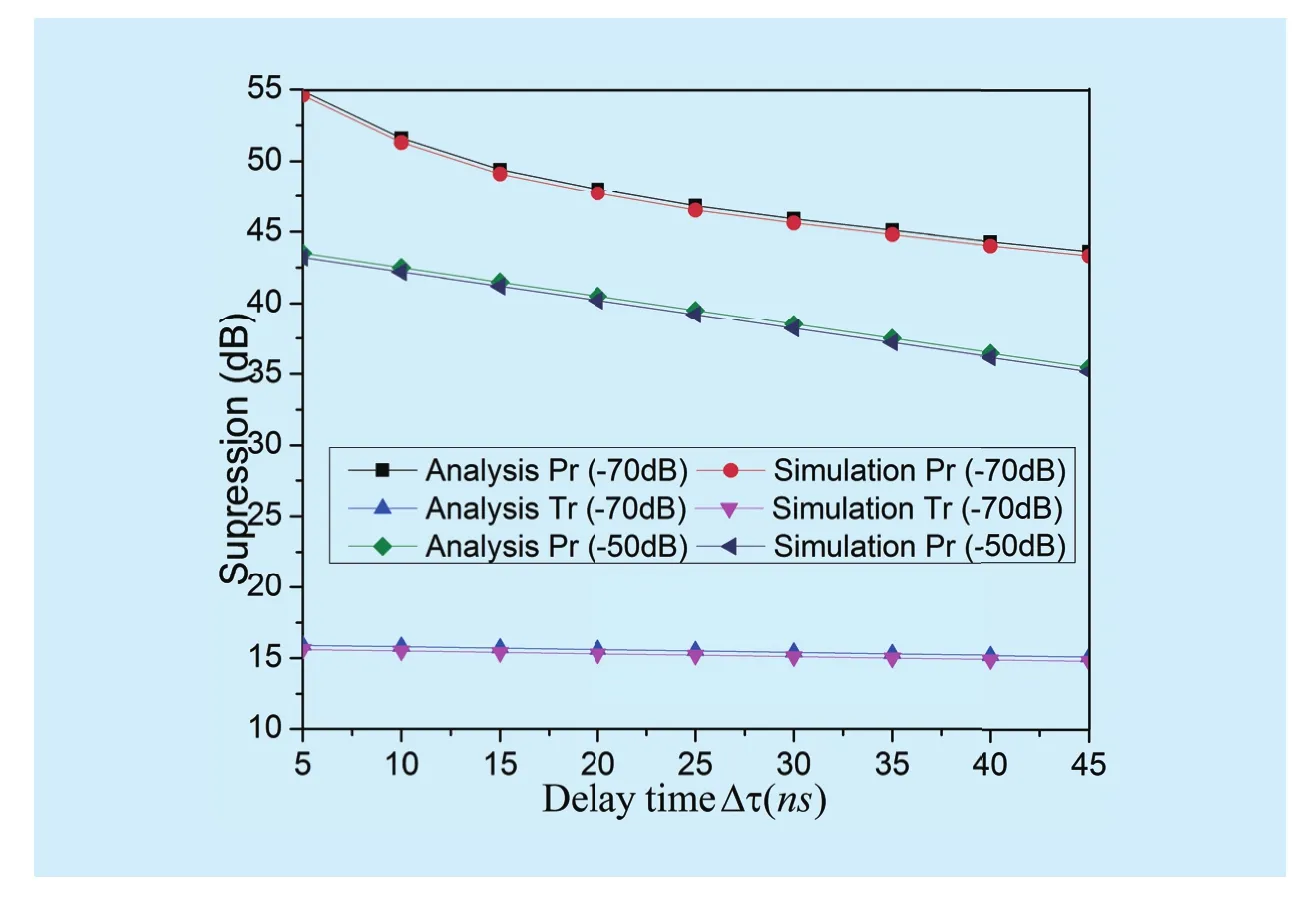
Fig. 3 Nonlinearity effects
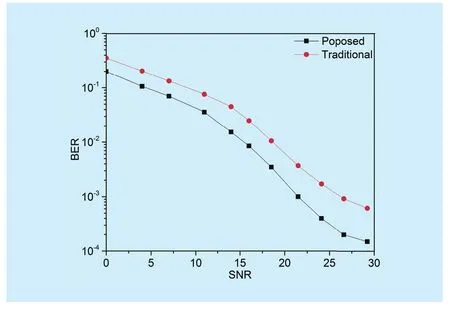
Fig. 4 3-D Beamforming performance over BER
Now, the overall performance of proposed 3-D beamforming scheme is compared with the traditional adaptive beamforming self-interference cancellation scheme [24]. The comparison is carried out in the BER and SNR domain. The results in figure 4 illustrate that initially the proposed scheme has minor difference of BER around (0.5dB) than traditional scheme. While, the gradual rise in SNR is also changes the trend and the BER difference goes up to (1.2E-04). It is proved by results that the proposed scheme has better BER around (1.2E-04) performance than traditional scheme, because of self-interference suppression in CCFD to improve efficiency of 3-D beamforming scheme.
It can be observed from results that the proposed scheme has better outcome due to sharing non-linearity, quantization noise and phase noise by feedback path with receiver to suppress the self-interference. While, the traditional scheme estimates the self-interference elimination information by baseband transmissions signal which is not a quite efficient method.
VI. CONCLUSION
In this paper, physical feedback based self-interference cancelation in CCFD is proposed to amend the effectiveness of spectral and energy consumptions in the 3-D beamforming.However, the self-interference is suppressed by the non-linearity, quantization noise and phase noise information of transmission is shared with receiver by the physical feedback path. Furthermore, the feedback channel and receiver radio share the same local oscillator to eliminate the self-interference in CCFD.The simulation and analytical outcomes of self-interference cancelation and BER are accumulated to raise the system performance.The results endorse that the performance of the proposed system is superior to traditional one. The future work will focus on improving the impact of receiver path nonlinearity which seems a challenging yet interesting research domain.
ACKNOWLEDGMENT
This work was supported by National Natural Science Foundation of China (Nos. 61172107,61172110), National High Technical Research and Development Program (863 Program) of China (No. 2015AA016306), Major Projects in Liaoning Province Science and Technology Innovation (No. 201302001), and Fundamental Research Funds for the Central Universities of China (No. DUT13LAB06).
[1] G. J. Foschini and M. J. Gans, “On limits of wireless communications in a fading environment when usingmultiple antennas,” Wireless Personal Communications, vol. 6, no. 3, pp. 311–335,1998.
[2] E. Telatar, “Capacity of multi-antenna Gaussian channels,” European Transactions on Telecommunications, vol. 10,no. 6, pp. 585–595, 1999.
[3] F. Rusek, D. Persson, B. K. Lau et al., “Scaling up MIMO: opportunities and challenges with very large arrays,” IEEE Signal Processing Magazine,vol. 30, no. 1, pp. 40–60, 2013.
[4] R. Couillet andM. Debbah, “Signal processing in large systems: a new paradigm,” IEEE Signal Processing Magazine, vol. 30, no. 1, pp. 24–39,2013.
[5] 3GPP TR 36.814 V9.0.0, Evolved Universal Terrestrial Radio Access (E-UTRA); Further advancements for E-UTRA Physical layer aspects.
[6] F. Boccardi, R. W. Heath, A. Lozano, T. L.Marzetta, and P. Popovski, “Five disruptive technology directions for 5G,” IEEE Communications Magazine, vol. 52, no. 2, pp. 74–80, 2014.
[7] Li, Yan, et al. ‘Dynamic Beamforming for Three-Dimensional MIMO Technique in LTE-Advanced Networks,” International Journal of Antennas and Propagation, Volume (2013), p.8,Article ID 764507, 2013.
[8] P. Zetterberg, “Performance of antenna tilting and beamforming in an urban macrocell,” in Proceedings of the 1st International Conference on Wireless Communication, Vehicular Technology, InformationTheory and Aerospace and Electronic Systems Technology, Wireless (VITAE ’09),pp. 201–206, Aalborg, Denmark, May 2009.
[9] N. Seifi; J. Zhang; R.W. Heath; T. Svensson; M.Coldrey, “Coordinated 3D Beamforming for Interference Management in Cellular Networks,”in Wireless Communications, IEEE Transactions on , vol.13, no.10, pp.5396-5410, Oct. 2014 Doi:10.1109/TWC.2014.2349981.
[10] H. Hardy; S. Stephan; K. Johannes; H. Cornelis,“3D beamforming: Performance improvement for cellular networks,” in Bell Labs Technical Journal , vol.18, no.2, pp.37-56, Sept. 2013 doi:10.1002/bltj.21604.
[11] A. Adhikary, J. Nam, J. Ahn, and G. Caire, “Joint spatial division and multiplexing The large-scale array regime,” IEEE Trans. Inform. Theory, vol. 59,no. 10, pp. 6441–6463, Oct. 2013.
[12] T. L. Marzetta, “How much training is required for multiuser MIMO?,”in Proc. Asilomar Conf.Signals, Systems and Computers, Oct./Nov. 2006,pp. 359–363.
[13] Chen, S., Beach, M., & McGeehan, J. (1998).Division-free duplex for wireless applications.Electronics Letters, vol. 34, no. 2, pp. 147-148, 22 Jan 1998. Doi: 10.1049/el:19980022
[14] A. Oppenheim, R. Schafer, Discrete Time Signal Processing. 3rd ed., Upper Saddle River, NJ:Prentice Hall, 2009
[15] B. Radunovic, D. Gunawardena, P. Key, et al.,“Rethinking indoor wireless mesh design: Low power, low frequency, full-duplex,” in WIMESH,pp.1-6, 2010.
[16] J. I. Choi, M. Jain, K. Srinivasan, et al., “Achieving single channel, full duplex wireless communication,” in MobiCom, pp. 1-12, 2010.
[17] M. Jain, J. Choi, T. M. Kim, et al., “Practical, real-time, full duplex wireless,” in Mobile Computing and Networking, pp. 301-312, 2011.
[18] S. Hong, J. Mehlman, S. Katti. “Picasso: Flexible RF and Spectrum Slicing,” in SIGCOMM12, pp.13-17, 2012.
[19] M. Duarte, C. Dick, A. Sabharwal, “Experiment-Driven Characterization of Full-Duplex Wireless Systems,” IEEE Trans. Wireless Commun., vol. 11, no. 12, pp. 4296-4308, 2012.
[20] A. Sahai, G. Patel, and A. Sabharwal, “Pushing the Limits of Full duplex: Design and Real-time Implementation,” in Rice University Technical Report TREE1104, 2011.
[21] W. Zhang, X. Zhou, L. Yang, Z. Zhang, B. Y.Zhao, and H. Zheng. 2011. 3D beamforming for wireless data centers. In Proceedings of the 10th ACM Workshop on Hot Topics in Networks (HotNets-X). ACM, New York,NY, USA, Article 4, p. 6. DOI=http://dx.doi.org/10.1145/2070562.2070566
[22] Sahai, A.; Patel, G.; Dick, C.; Sabharwal, A., “On the Impact of Phase Noise on Active Cancelation in Wireless Full-Duplex,” IEEE Transactions on Vehicular Technology, vol.62, no.9,pp.4494,4510, Nov. 2013.
[23] 3GPP TR 36.873 V2.0.0 ‘3rd Generation Partnership Project,Technical Specification Group Radio Access Network,Study on 3D channel model for LTE (Release 12)”
[24] Y. Lu, J. An, “A Type of Adaptive Beamforming for Self-Interference Cancellation over Aeronautical Channel,” 4th International Conference on Wireless Communications, Networking and Mobile Computing (WiCOM ‘08). vol., no., pp.1,4,12-14 Oct. 2008
- China Communications的其它文章
- A Privacy-Based SLA Violation Detection Model for the Security of Cloud Computing
- Empathizing with Emotional Robot Based on Cognition Reappraisal
- Light Weight Cryptographic Address Generation (LWCGA) Using System State Entropy Gathering for IPv6 Based MANETs
- A Flow-Based Authentication Handover Mechanism for Multi-Domain SDN Mobility Environment
- An Aware-Scheduling Security Architecture with Priority-Equal Multi-Controller for SDN
- Homomorphic Error-Control Codes for Linear Network Coding in Packet Networks

